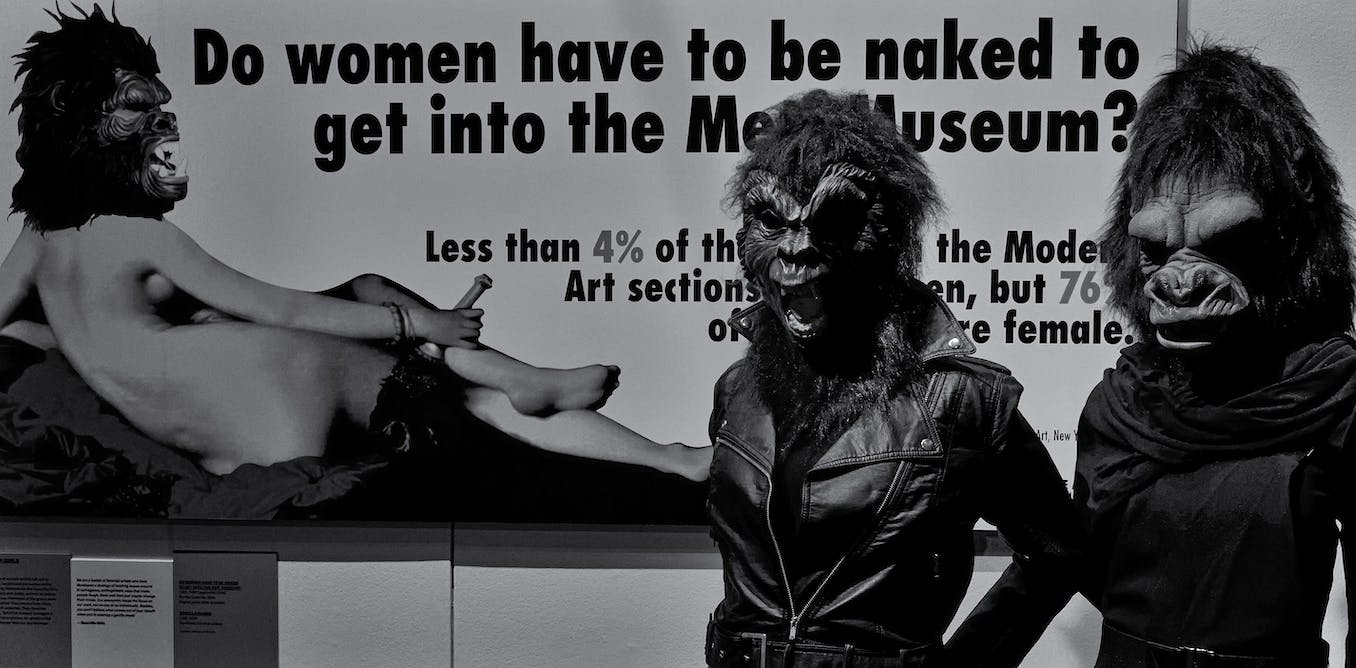|
Getting your Trinity Audio player ready...
|
We challenge you to name, off the top of your head, a few women artists exhibited in museums. If male names come more readily to mind, it’s not by chance: women, in art as in many other spheres associated with a form of power, influence or prestige, are far less recognised, exhibited and studied than their male counterparts.
Female artists’ feeble presence in museums
The anger over this state of affairs boiled over decades ago. Back in the 1980s, the Guerrilla Girls, a collective of anonymous women artists, took issue with the lack of representation of women at the MoMa’s “International Retrospective of Contemporary Painting and Sculpture”, which aimed to showcase the biggest names in contemporary art. Of the 169 artists chosen, only 13 were women – less than 8%. The feminists would ask a question that would go on to ring into the 21st century: “Do women have to be naked to get into the Met museum?
According to recent research, there are still few women artists in museums. In the United States in 2019, in the 18 largest museums in terms of visitor numbers, 87% of the artists exhibited in the permanent collections were men. Similarly, in France, a 2021 study lists 93.4% male artists in the catalogues of national public museums.
One might retort that a good number of European exhibitions have been devoted to women artists of late. The Parisians will put forward the Centre Pompidou’s “Women in Abstraction” (May-August 2021) or the Musée du Luxembourg’s “Pioneers”, while Madrilenians can boast “Women Masters, Old and Modern” (October 2023–February 2024), a retrospective of the period from the late 16th century to the early decades of the 20th century curated by the Spanish art historian Rocío de la Villa. In Hamburg, “Ingenious Women” (October 2023–January 2024) traced the careers of women artists from 16th to the 18th century, placing their works alongside those of their fathers, brothers, husbands, and fellow painters.
In fact, such a proliferation only underscores the problem of gender inequality: male artists do not need to be associated with a specific category to be the subject of thematic or monographic exhibitions. They have had nearly the entire space to themselves for centuries. To correct this inequality, efforts are being made to shine a light on women by creating exhibitions dedicated to them. But as an article in Le quotidien de l’art pointed out in 2021:
“There is a danger that this kind of initiative will lump together artists who have little in common other than their gender, and reduce them to the same category.”
Why are women so rarely represented in museums? The difficulty women artists have in finding their place in art museum catalogues is reminiscent of the difficulty women have in breaking through the glass ceiling in the corporate world.
As this subject is now well documented in management literature, we can attempt to draw parallels with the reasons for the low representation of women artists in museum catalogues and exhibition halls.
Stereotypes and presumption of unfitness
A first element of explanation seems to be linked to gender stereotypes, with the presumption that women are unfit to create “official” art. Historically, in France, art was legitimised by the Royal Academy of Painting and Sculpture, created by Cardinal Mazarin in 1648, which organised a salon, an annual exhibition of official artists, validated by judges from the Academy. It was there that the state bought works for display in museums. Between 1800 and 1830, women accounted for no less than 14% of exhibitors at the salon, but only 1.74% in the museum catalogues of the time, failing to break the glass ceiling set by the male experts at the Académie.
Nowadays, women’s access to strategic positions in organisations continues to heavily rely on their male counterparts’ assessment. Since the 1970s, a number of studies have shown that “masculine” characteristics are more widely associated with the ideal type of leader. Despite increasing numbers of women in business and academia, these stereotypes are relatively stable, particularly among men who perceive women as unsuitable for strategic managerial positions.
“Think artist, think male”
As Trasforini notes:
“In art, we associate the author, the man, the maker, while women are the ‘author’ not of a work but of a useful and often collective product.”
Our instinctive association of artistic genius with the male gender stems from a broader tendency to link leadership roles with men – a psychological phenomenon known as “Think manager, think man”. Our 2018 study concurs with this view, highlighting the qualities of a leader are particularly associated with so-called “masculine” characteristics. In contrast, interviewees thought women lacked the agency (determination, confidence, independence, etc.) to be skilled leaders.
This assimilation of man-leader, man-artist feeds a vicious circle that keeps women away from positions of power in companies and ambitious projects in the art world.
Differentiated access to opportunities
Even if a small number of women artists manage to be exhibited in museums, historically, they remain mostly confined to less prestigious painting genres (portraits, still life, miniatures). The Académie established a hierarchy of genres, with history painting, depicting heroic figures, and the “petit genre”, depicting intimate or light subjects, at the top, followed by landscape and still life.
Long sidelined from sculpture, the study of the nude and the major genres of painting, several women artists, such as Elisabeth Vigée Le Brun and Rosalba Carriera, nevertheless made their mark in portraiture. However, the more women devoted themselves to this “modest” type of art, the less they were exhibited and the less their works were brought to posterity, i.e. displayed in museums.
Network and influence
Beyond the gender of the art, the work and the talent, the recognition and quality of a work depend very much on the opportunities it has to meet the public and the financial and human resources available to the artist. The Prat report (2009) underlines this reality, which is not favourable to women because of their limited access to networks that enable the sharing of know-how, means of production and work tools.
Unequal access to professional networks and influential people limits women artists’ opportunities for development, visibility and recognition. Male social networks, which generate active solidarity, have no female equivalent, or only marginal ones. Access to institutions and exhibitions eludes them while they are still alive; and once they are gone, their work has no access to archives, and so cannot arouse the interest of curators.
Similarly, to access strategic positions in companies, it is necessary to be part of networks of influence in order to forge links, build social capital and be able to seize opportunities and emerge as leaders. Compared with men, women have more difficulty accessing professional networks, which limits their access to leadership roles. Studies show that women also have less access to influential sponsors and mentors who can help them accelerate their careers and reach senior positions.
Despite equal access to education, opportunities are still unequal: women artists account for 60% of school pupils in France, but only 10% of award-winning artists.
It’s time to break this vicious circle that minimises women both in positions of power and in museums, and to (re)ask the question “Where are the women?”.



